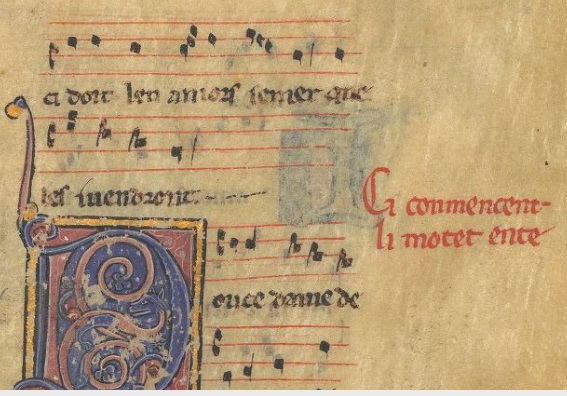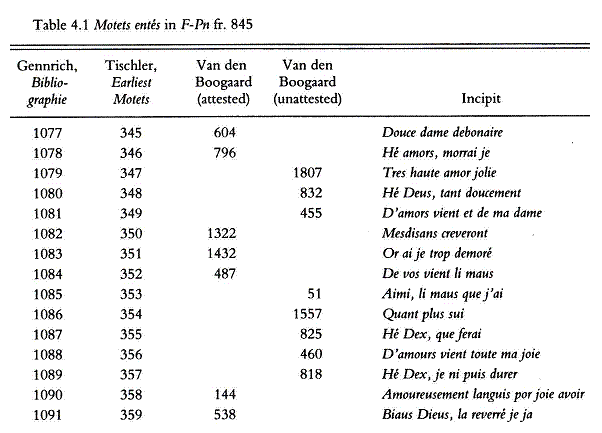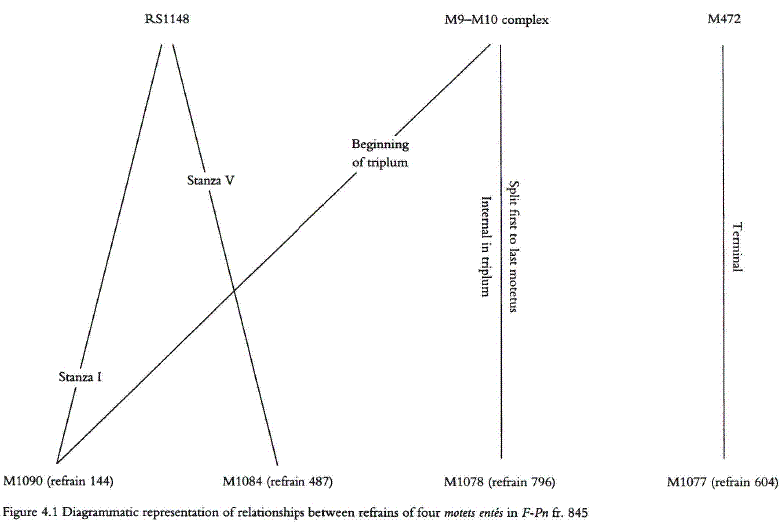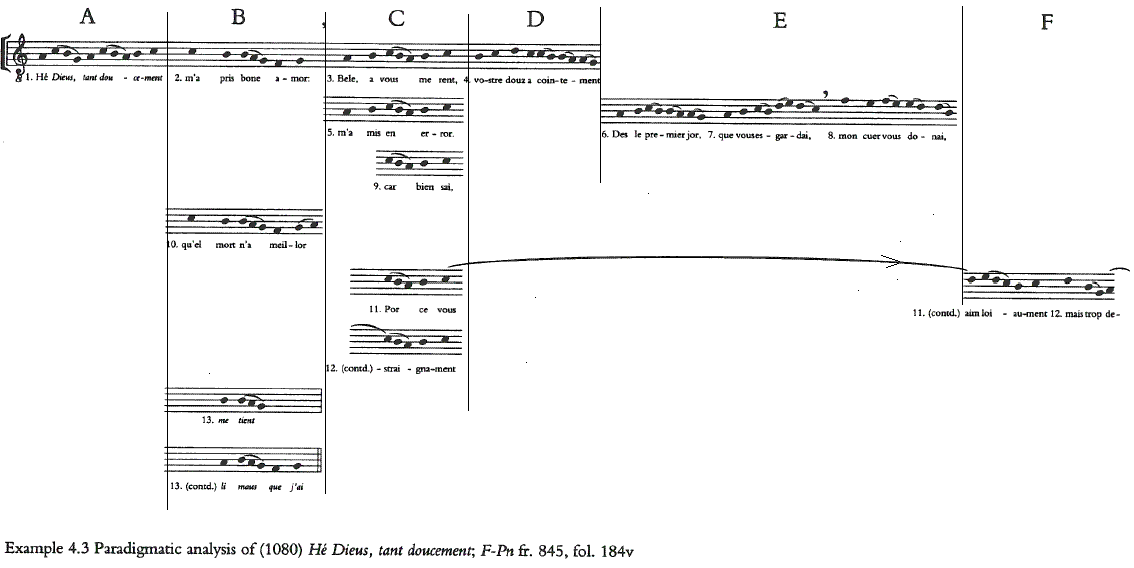| French Motet in the Thirteenth
Century8 |
| 音楽エッセイのページへ戻る | 初期多声音楽 | St.マーシャル楽派へ |
| Leoninのページへ | ノートルダム楽派(conductus)のページへ |
ペロタン(Viderunt Omnes) |
| ペロタン(Alleluja Nativitas) | ペロタン Clausulaのページ | まうかめ堂さんのページへ |
| substitute clausulaのページへ | 中世音楽のページへ | 前のページへ |
| 次のページへ |
| Motet
ent The correlation of the term ‘motet ente' with a group of pieces could not be clearer. At the beginning of a sequence of compositions in fran^ais 845 there is the rubric‘Here begin the motets entes' This manuscript is one of the so−called KNPX group of chansonniers14 and is closely allied with the Arsenal chansonnier, Paris, Bibliotheque de 1'Arsenal, 5198.15 Both books must have been copied around 1270-80. ‘motet ente'という言葉と作品グループの関連はあまりはっきりしない。fran^ais 845中の作品の始まりには、‘Here begin the motets entes'と書かれたルブリックがある。この写本はシャンソン集のいわゆるKNPXと呼ばれるものである。そしてArsenal chansonnier, Paris, Bibliotheque de 1'Arsenal, 5198と密接に関連している。両者は 1270-80年頃に作成されている。  fran^ais 845 fol.184r http://gallica.bnf.fr/ark:/12148/btv1b6000955r/f377.item.zoom Therefore the collection of motets entes in fran^ais 845 is more or less contemporary with the motet collections in Bamberg and the corpus ancien of Montpellier, rather younger than the French motets in W2 and older than the later fascicles of Montpellier and the motets in Turin. There are fifteen works called motet ente in fran^ais 845, but they are compositions that relate only tangentially to the mainstream of motet composition preserved in the other sources. それゆえ、 fran^ais 845写本中のmotets entesのコレクションは、多かれ少なかれ、バンベルク写本中やモンペリエ写本中の古い部分のモテットコレクションと同時代のものである。W2写本よりは後のものだが、モンペリエ写本の後期やTurin写本よりも古い。fran^ais 845写本中の15作品がmotet enteと呼ばれるが、それらは他のソースに保存されているモテット作品の主要な流れに接している程度のものである。 First of all, the works are monophonic. Despite the fact that Gennrich describes them all as two-part motets with the tenor missing, neither their manuscript presentation nor their concordant versions support such a view. Like the music in the rest of the manuscript, the works are notated successively in two columns. 0f the fifteen works preserved there, twelve are unique. Two works have concordances in the chansonnier Douce 308 but without music. A final piece is also preserved not only in Douce 308 but also in a romance entitled Meliacin or Le Conte du Cheval de Fust. This itself is preserved in four contemporary sources.16 Again, however, none of these records any music. これらのうちの最初のものは単声作品である。Gennrichはこれらすべてがテノールのない2声モテットと記載しているが、こうした見方を支持する写本等はない。写本外の音楽のように、作品は2列に記譜されている。15作品のうち、12作品はuniqueである。2作品はchansonnier Douce 308中にconcordanceがある(音楽なし)。最後の作品はシャンソン集Douce 308中だけでなく、Meliacin or Le Conte du Cheval de Fust.と名付けられたロマンス中にも存在する。これ自身は4つの同時代のソースにも保存されている。いずれにせよ、これらには音楽はついていない。 lnformation about the corpus of motets entes in fran^ais 845 is given in Table 4.1. Reading from left to right, there are two numbering systems: one from Gennrich's Bibliographic, and the other from Tischler's Earliest Motets where the pieces are edited. Two columns giving information about the refrains in these pieces are followed by a textual incipit. The information about the refrains is divided into two columns; the numbers a11 refer to the inventory by Nico van den Boogaard. 0n the left are attested refains and on the right unattested ones. This allows us to maintain a distinction between refrains which survive in locations other than these motets,and those that do not, during the course of the following discussion. fran^ais 845 写本中のmotets entesのモテットについての情報はtable4.1である。  Of the fifteen refrains that are supposed to form part of these fifteen pieces, seven occur in other contexts (and are in the ‘attested' column), while eight do not. In other words, this is the only appearance that these eight make in the entire repertory of lyric and narrative verse and music. 0f these fifteen works, only six behave like motet entes as described by Ludwig: their refrains are divided into two portions and placed at the beginning and end of the piece. But of these, only four have refrains that appear elsewhere. We cannot make any judgement on the validity of the two works whose refrains do not survive elsewhere. Their texts certainly behave like the ones whose refrains do have concordances. We simply cannot be certain whether to include siχ works of this sort in our discussion, or to assume that two are fictions。 これら15の作品の一部を形成するべき15のrefrainのうち、7つは他の作品(上表の「証明された」部分)にも含まれ、8つはそうではない。言い換えるとこれは、これら8つの作品は、全体として、叙情詩や物語詩、音楽の全レパートリーで作ったものであるといえる。これら15作品のうち、6つは、Ludwigによって規定されたmotet enteとして振舞う。こうしたrefrainは2つの部分に分けられ、作品の最初と最後にそれぞれ置かれる。しかしこれらのうち、2作品はそのrefrainが他所では現存していない。これらの歌詞は、refrainが共有されていないように振舞う。我々は、単純に、こうした6作品を議論の対象とするかは定かではないし、ふたつは実物ではないと考えている。 Figure 4. 1 represents graphically some of the relationships between the refrains of the pieces in this subgroup。 Figure 4. 1は、これらサブグループのrefrain間の関連をグラフ化したものである。  There are only three other works involved in this complex of pieces. This is a strikingly narrow circulation for the four refrains. The three locations of the refrain are a motetus from a three-part motet in the fifth fascicle of Montpellier,17 both upper voice-parts of a further motet again from the fifth fascicle of Montpellier but also preserved in other manuscripts,18 and two stanzas of a chanson avec des refrains (RS 1148). This latter song is preserved in the KNPX chansonnier group, and of course therefore in fran^ais 845. Two refrains go into the first and fifth stanzas of the chanson. One refrain simply appears at the end of a voice-part, marked ‘terminal' in Figure 4.1, but refrains 796 and 144 occupy a rather more complex position in another motet. この作品の複合体に含まれる3つの他の作品がある。これは、4つのrefrainの注目すべき狭い範囲での使い回しである。refrainの3つの存在場所は、モンペリエ写本中の第5冊子中における3声モテットのmotetusである。その他のモテットの上声部はモンペリエ写本の第5冊子からのものであるが、他の写本やchanson avec des refrains (RS 1148)中のふたつのスタンザにも保存されている。この後の方の歌は、KNPXシャンソン集グループにも保存されており、無論、fran^ais 845にもある。ふたつのrefrainはシャンソンの第1、5スタンザに入っている。ひとつのrefrainは、単純に声部の最後に出現する(Figure 4. 1では'terminal'と表現されている)。しかしrefrains 796 と 144 はむしろ、他のモテットにおいて、より複雑化している。 (9) Amoureusement me tient - (10) He,Amour Omnes (M1), identified as ‘M9-M10 complex' in Figure 4.1 is a piece whose use of refrains will be discussed in Chapter 6. What can be said is that its presence within this group of pieces yet again breaks down the idea that it conforms to the neat picture usually painted of the ways in which refrains function in motets: that the refrain is taken from a chanson or rondeau and then quoted within the context of the motet. Although there are four or perhaps six works that seem on the surface to behave very much according to the description offered and used by Ludwig, Anderson and Rokseth, the highly restricted distribution of the refrains in those pieces, where they are attested, immediately sets them apart from the ones which those authors were in fact seeking to eχplain。 (9) Amoureusement me tient - (10) He,Amour Omnes (M1)は、Figure 4.1において‘M9-M10 complex'として同定されるが、この作品は、そのrefrainの使用が第6章で論じられる。言われるべきことは、再度またこのグループの作品の存在が、refrainがモテット(そのrefrainがシャンションやrondeauから取られ、モテット内容に引用される)中に機能するやり方を描いた上品な絵となるようなアイデアを壊す、ということである。Ludwig、Anderson and Roksethによって提案されたように表面的には振舞う4あるいは6つの作品があるが、これらの作品中のrefrainの厳格な分配は、直接、その著者らが実際に説明を求めたものからは離れることとなる There are three other compositions in fran^ais 845 that make use of refrains that are known from other sources. The version of the last piece in Table 4. 1 survives in too fragmentary a form to make any particular statement about the way in which it works. The two other pieces, (1082) Mesdisans creveront and (1083)‘Or ai je trop demore,are worth closer eχamination. Mesdisans creveront uses a three-line refrain that it splits into three sections and disposes at the beginning, middle and end of the piece. Unfortunately none of the other versions of the refrain is preserved with music. fran^ais 845には、他のソースで知られているrefrainを用いる3つの他の作品がある。Table 4. 1中にある最後の作品の版は、あまりに断片的にしか残っていないので、refrainがどのように働いているかについて等、言明することが困難である。他の2つの作品 (1082) Mesdisans creveront and (1083)‘Or ai je trop demoreは、より緊密な調査に値する作品である。Mesdisans creverontは、作品の最初、中間、最後に置かれた3セクションを分ける3行refrainを使っている(音楽なし)。 0r, ai je trop demore,no.1083, is of interest for rather different reasons (Examples 4.2.1 and 4.2.2). This piece exhibits characteristics that are found consistently in this repertory of motets entes in fran^ais 845. These characteristics will form the basis of conclusions concerning this music.19 0r,ai je trop demore,no.1083, は、興味があり、かつむしろ異なった理由に対して興味を持たれるように思う。 この作品は、絶えず、 fran^ais 845中のmotet entesのレパートリーに見出される性質を持っている。こうした性質は、この音楽に関する判断の基礎を形成する。  1n Example 4.2.1, the refrain can be seen divided into two and placed at the beginning and end in exactly the same way as in the group of four pieces discussed before. These are teχt-lines l and 12 and are here italicised. The music to each of the two limbs of the refrain is different. However, in the penultimate line of the text (line 11) the music is exactly the same as the first line of the refrain − at the beginning of the piece. It is difficult to stress sufficiently how important − and how rare − this sort of repetition is. Previous discussion has demonstrated the absence of melodic repetition in the newly composed sections, excluding the occasional refrains, of the thirteenth-century motet。 Phrases may begin like the one two before it, for example, but it can be guaranteed that it will not continue in the same way. Such a self-conscious avoidance of melodic repetition has much to do with the fact that both the rhythmic and harmonic vocabulary of the music is highly restricted, and the skill in creating variety depends on the constant melodic permutation of a limited number of pitches. Example 4.2.1において、refrainは前述のように配置されている。refrainのふたつのlimbのおのおのへの音楽は異なっている。しかしながら、第11行において、その音楽はrefrainの最初の行と全く同じである。しかし、この種のものを「繰り返し」と言うことはさほど重要な問題ではない。以前の議論において、新しく作曲された13世紀モテット部門において、偶然のrefrainを排除した、旋律の繰り返しの欠如を証明した。フレーズはその二つ前と同様かもしれないが、たとえば、同じようなことが続くとは限らない。こうした、旋律の繰り返しの意識的な忌避は、音楽のリズム的、ハーモニー的語彙が強く制限され、多様性を想像するスキルが制限されたピッチ数の旋律配列に依存するという事実と関係がある。 To repeat: the pieces in fran^ais 845 exploit musical parallelisms, and an exploration of the differences between these pieces and the rest of the motet repertory really stands at the core of the current argument. Such relationships between individual compositions in fran^ais 845 have not gone unnoticed, but they have not however been used to reassess the motet ente. In his editions of this music in The Earliest Motets Tischler was not only aware of them, but used them instead to interfere editorially with some textual problems.20The repetition that can be witnessed in 0r,ai je trop demore, then represents a rather special approach to melodic construction. It stands apart from more common melodic practices in the motet, and for that matter in other species of discantus: clausula and cauda (in conductus) and also in organum triplum and quadruplum. 繰り返そう。fran^ais 845写本中の作品は、音楽の並行性を利用しており、こうした作品とモテットレパートリーの残り部分の間の違いを探ることは、現在の論議の中核を担っている。 fran^ais 845中の個々の作品間のこうした関係は、注目すべきことではるが、しかし、motet enteを再評価するためには利用されない。The Earliest Motets において、Tischlerは、こうしたことには気づかず、その代わり、いくつかの歌詞の問題に監修者として干渉していた。0r,ai je trop demoreに見られる繰り返しは、むしろ、旋律作成への特殊なアプローチを示している。モテット中のより一般的な旋律実践とは別の種類のディスカント、クラウズラ、カウダ、でありまた、オルガヌム中のtriplumあるいはquoadroplumである。 Once we have observed that the penultimate line of text is set to the same music as the first line of the refrain, we are then alerted to other more thoroughgoing series of melodic repetitions in this piece. These are indicated in Example 4.2.2. The music to teχt-lines 4 and 10 is more or less identical; the only exception is a single ornamental note in the cadence. In addition, one could argue that the music to teχt line8 represents an ‘open' form, transposed, of the more closed lines 4 and 10. One might also give serious thought to considering the music to teχt-lines 5 and 9 in a similar fashion. Much is the same except that line 5 is longer than line 9, and the music is correspondingly elongated。 refrainの第1行と同じ音楽がつけられた歌詞を持つpenultimate lineを我々は以前観察したが、その時には、この作品中の旋律の繰り返しの連続に驚いたものだった。これを示したのがExample 4.2.1の囲み部分である。第4行と10行の旋律はほぼ同一である。唯一の例外は、カデンツにおける1つの装飾音のみである。これに加え、第8行の旋律はオープンな形であり、第4、10行は閉じた形となっている。同じ立場で、第5、9行の歌詞への旋律を考えることは興味深い。第5行は第9行よりも長いが、それに相応して旋律もまた長くなっている。 Such a process of internal musical repetition is one of the most striking features of the fifteen works appended to fran^ais 845. 1t is present in 0r,ai je trop demore which we have just been examining, but it is also present, to a greater or lesser extent, in ten out the fifteen works in this repertory. Four out of the five that do not eχhibit this characteristic are the works discussed and graphed in Figure 4.1: those pieces that employ a refrain found in other sources, and that divide it neatly into two halves and place it at the beginning and end of the composition. The one remaining piece is (1091) Biaus dieus where the textual disturbance is too great to make any incontrovertible judgement。 こうした音楽内部の旋律の繰り返し過程は、fran^ais 845に属する15作品の際立った特徴の一つである。この0r,ai je trop demoreと同じような例は、15作品中、10作品で見出される。残りの5作品中の4作品はこうした性質を示さないが、その4作品は、Figure 4.1で示されている。こうした作品は、他のソースにおいてもrefrainが見出されており、そして作品の最初と最後でうまく2つに分かれている。残りの1作品は(1091) Biaus dieusであるが、歌詞の混乱が非常に大きく、評価ができない。 A discussion of one further work from this repertory will investigate the nature of such repetition in slightly more detail. The piece is He Dieus, tant doucement, and Example 4.3 presents a paradigmatic analysis of the composition based on a new unmeasured edition. The organisation of this analysis follows that of the one in the previous chapter. The primary criteria for segmenting the work are the divisions into line-length and musical phrase. It may be seen how lines 11 and 12 articulate smaller units. Initially, paradigms B and C offer full repetitions (lines 10 and 5 respectively) after which the repetitions dissolve into fragments. Line 13 is here described as two units under paradigm B.21 Similarly paradigm C breaks down after the initial repetition of line 5 with a fragment that equals the whole of line 9. That same fragment reappears at the beginning of line 11. Its continuation is quite new, and therefore stands well to the right of the graph. The immediate continuity is indicated with a slur. Again the same fragment occurs at the end of line 12. It functions as the inverse of line 11 because its beginning is new and again lies to the right of the graph。 このレパートリーからのさらなる作品における論議は、こうした繰り返しの性質に関するより詳細な調査を行うことになるだろう。He Dieus, tant doucementは、Example 4.3にその分析がされている。パラダイムB,Cは、完全な繰り返しとなっており、繰り返しは断片に分解される(後略)。   Much of this piece does not form part of a pattern of repetitions. Lines 6−8 1ie outside the scheme as outlined in Example 4.3, but would tall inside a structure based on a more systematic analysis of the subunits of lines. Nevertheless, the analysis, as it stands here, does demonstrate a substantial degree of melodic repetition much in line with the rest of the repertory of motets entes in fran^ais 845. Again, it needs to be stressed that this piece and the one previously examined behave in a radically different fashion to the major part of the thirteenth-century motet repertory。 この作品の一部分は繰り返しパターンを形成していない。第6〜8行はExample 4.3におけるスキーム外である。しかし、行のサブユニットのよりシステマティックな分析を基にした構造内で高くなることだろう。にも拘わらず、分析によって、 fran^ais 845中のmotet enteのレパートリーの残りの部分と同じくらい、かなりの程度の旋律の繰り返しがあることが示されている。この作品とこれまで調査されたものは、13世紀のモテットのレパートリーの多数部分とは異なった状態となっている。 This specific musical characteristic − complex patterns of internal repetition − is found in ten out of fifteen compositions in the manuscript fran^ais 845. We may wonder if、when the scribe of fran^ais 845 labelled these pieces motet ente, he was pointing out this specifically musical characteristic of ‘grafting' the same musical units on to the rest of the text. There is a difference between these pieces exhibiting characteristics of melodic repetition and those that simply borrow a refrain, divide it into two and place it at beginning and end of a voice-part.While the latter is found more commonly in the motet repertory at large, the former is unique to the collection of pieces we have just been examining. Furthermore, twice as many pieces in this group employ the sort of melodic repetition which we have observed than behave as a motet ente in the sense that Ludwig understood it. It will not be out of place to restate the fact that, first, all the motets entes in fran^ais 845 are monophonic, and, second, they are preserved in a notation markedly different to that found in such contemporary motet books as Montpellier, Bamberg or even W2.22 この特殊な音楽的特徴−複雑な内部繰り返し構造−は、fran^ais 845写本中の15作品のうちの10作品に見出される。fran^ais 845写本の作者がこうした作品をmotet enteでラベル付けした時、彼が残りの歌詞の同じ音楽的単位を移植する音楽的特徴を示したかどうかは、明らかではない。旋律の繰り返しの特徴を示したこうした作品と、refrainを単純に借用しそれを二分して声部の最初と最後に配置する作品との間には差異がある。後者はモテットレパートリーにより普通に広範囲に見られるが、前者は我々が調査したコレクションに特異的なものである。さらに、このグループの2倍の作品は、Ludwigが理解した感覚でのmotet enteのような振る舞いよりも我々が観察した旋律の繰り返しを採用している。まず,fran^ais 845写本中のすべてのmotets entes はモノフォニックであり、 第二に、それらはモンペリエ写本、バンベルク写本、W2写本と同じ時代のモテット本において見られたそれとは著しく異なる記譜法において保存されているという事実を修正再表示することは場違いではない。 There is the very strong possibility that early twentieth-century scholarship developed the wrong element in this collection to support the designation motet ente. Reasons for suggesting this are clear: that this group of works functions on a self-referential basis in terms of their melodic organisation. There is one further piece of evidence that reinforces this view of these pieces as self-referential. That is the high degree of intertextual reference in the poems themselves, and this may be seen from the incipits of the poems given on Table 4.1。 20世紀初期の学問が、motet enteの概念をサポートするためのコレクションにおいて、誤った要素を発達させてしまった強い可能性がある。これを示唆する理由ははっきりしている。作品グループは、こうした旋律構成の面では、自己参照の基盤で機能する。自己参照としてのこうした作品の見方を強化する証拠があるさらなる作品がある。それは詩自身において相互参照する高い程度であり、そしてこれは、Table 4.1上のincipitsから認められる。 When we distance ourselves from the motets entes in frangais 845 and return to the mainstream motet repertory, we find that there are very good grounds for suggesting that we stop calling pieces motets entes that simply divide a refrain into two and place it at the beginning and end of a voice-part. We could then suggest that this music should be considered alongside all the other motets that employ such a variety of refrain usages. lt is just this variety that will be stressed in Chapter 8 by abandoning the term ‘motet ente , but continuing to work with a compositional premiss that includes such a division of a refrain。 frangais 845写本中のモテットから離れて、主流のモテットレパートリーに戻ってきたとき、我々は、単純にrefrainを二つに分けてそれらを声部の前後に配置する作品をmotets entesと呼ぶことをやめることを示唆する非常に良き基盤があることがわかる。我々はこの音楽が、refrainのさまざまな使用を認める他のすべてのモテットと一緒に考えられるということを示唆することができただろう。Chapter 8で強調されるのは、motet enteを放棄することだが、このようなrefrainの分割を含む作曲上の前提で作業を続けていくだけである。 At the beginning of this discussion of the motet ente, we considered two sorts of motet: one that simply used a refrain anywhere in a voice-part, and one that divided a refrain into two. One experiences some difficulty in finding straightforward examples of the latter that are not confused with other processes. In other words,when the repertory is considered as a whole, the range and variety of procedures is much greater than using the term‘motet ente’suggests. motet enteのこの議論の冒頭で、我々は2種類のモテットについてを考えた。ひとつは単純に声部のどこかでrefrainを使ったものであり、もう一つは、refrainを2つに分けたものである。他のプロセスと混同しない、後者の簡単な例を見つけるのは難しい。言い換えれば、レパートリーが全体として考慮されるとき、範囲および多様な過程は、‘motet ente’という用語を使用するよりはるかに大きい。 |